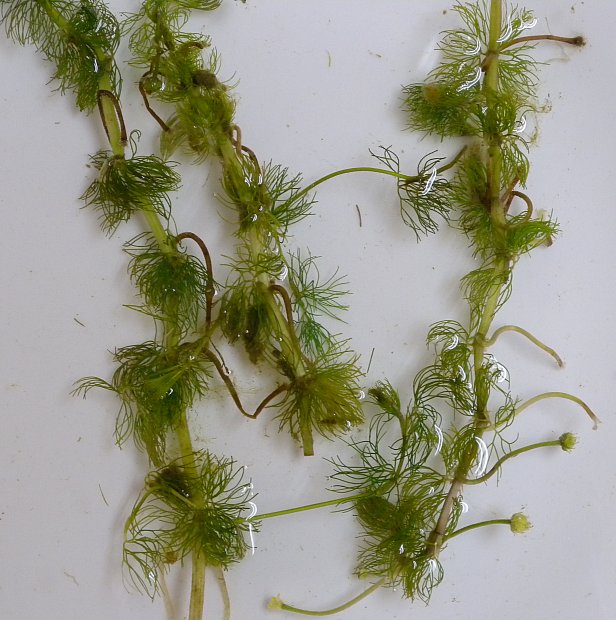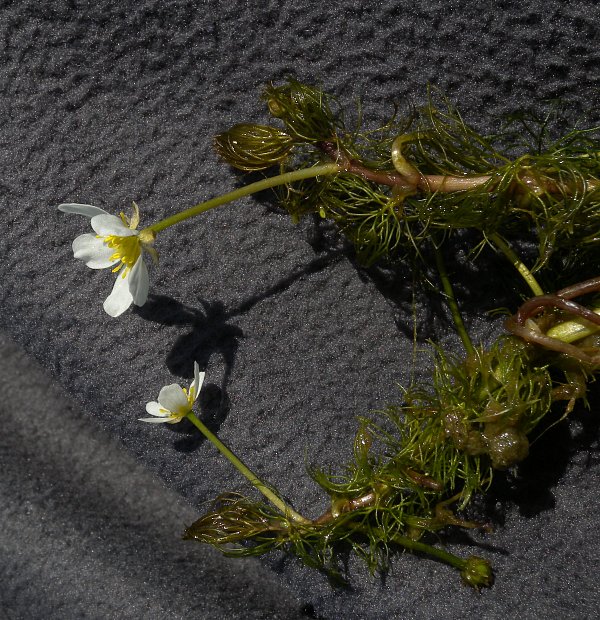
Each flower is ½–¾" across, consisting of 5 spreading white petals, 5 light green to light yellow sepals, a yellowish or yellowish green head of 8-25 pistils, and several yellowish stamens surrounding the pistils. The petals are oblanceolate to obovate in shape with rounded to nearly truncate tips; the bases of these petals are usually yellow. The sepals are lanceolate to broadly elliptic in shape; they are either widely spreading (underneath the petals) or somewhat declined. The filaments of the stamens are variable in length, even on the same flower. The blooming period occurs primarily during the summer, lasting about 2-3 months. Afterwards, the pedicels of the flowers curve downward into the water. The small seedheads are globoid-ovoid in shape and 4-5 mm. long. Individual seeds are about 1.5 mm. long, 1.0 mm. across, and somewhat flattened; they can spread to new locations by water currents or they are blown about by the wind on the water surface. At the bottom of each plant, the root system is shallow and fibrous. When the lower stem is decumbent on the water bottom, it can develop rootlets near the axils of the leaves. This plant often forms colonies.

Cultivation: The preference is full sun, shallow clear water up to 2½' deep, and bottom soil that is mucky, silty, or a mixture of sand and organic material. This plant prefers bodies of water where there is an absence of strong currents and where there is some protection from strong winds.
Range & Habitat: The native White Water Buttercup is occasional in northern Illinois, while in central and southern Illinois it is uncommon or absent (see Distribution Map). This map combines the distributions of Ranunculus longirostris and Ranunculus trichophyllus, as the latter two species are considered synonyms of Ranunculus aquatilis diffusus. White Water Buttercup (Ranunculus aquatilis) is widely distributed in both North America and Eurasia, where several varieties have been described. Habitats of this plant include shallow ponds, streams with slow currents, and deep ditches. White Water Buttercup can be found in both high quality and disturbed wetlands.

Faunal Associations: The flowers are cross-pollinated by bees, flies, and beetles (especially Prasocuris spp.). Both nectar and pollen are available as floral rewards; the beetles may also gnaw destructively on the flowers. Even though the foliage is somewhat toxic, some vertebrate animals make limited use of water buttercups as a source of food. The foliage and/or seeds of these aquatic plants are eaten by the Trumpeter Swan, Wood Duck, Muskrat, Snapping Turtle, and Blanding's Turtle (Bellrose, 1942/1976; Martin et al., 1951/1961; Lagler, 1943). The finely divided leaves provide cover for aquatic insects and other small invertebrates.
Photographic Location: A pond at a city park in Lake County, Illinois, and indoors.

Comments: Another common name is White Water Crowfoot. When this aquatic plant occurs in colonies, it is capable of a showy display because of its emergent flowers. It is similar in appearance to another aquatic plant, Ranunculus flabellaris (Yellow Water Buttercup), except the latter species has yellow flowers. In North America, there are at least two varieties of White Water Buttercup: Ranunculus aquatilis aquatilis and Ranunculus aquatilis diffusus. The typical variety is found in western North America and it has both submerged and floating leaves. The variety that is described here (var. diffusus) is found in eastern North America and it has only submerged leaves. Some authorities, e.g., Mohlenbrock (2014) and the USDA Plants website, divide Ranunculus aquatilis diffusus into two species, Ranunculus trichophyllus and Ranunculus longirostris. The former species is supposed to have achenes with shorter beaks and flexible leaves with longer petioles, while the latter species is supposed to have achenes with longer beaks and stiff leaves with shorter petioles. However, other authorities believe these characteristics freely intergrade in the field and they are influenced by environmental conditions (eFloras website, New England Wildflower Society website). Thus, according to them, White Water Buttercup in Illinois should be referred to as Ranunculus aquatilis diffusus. This latter viewpoint has been adopted here.